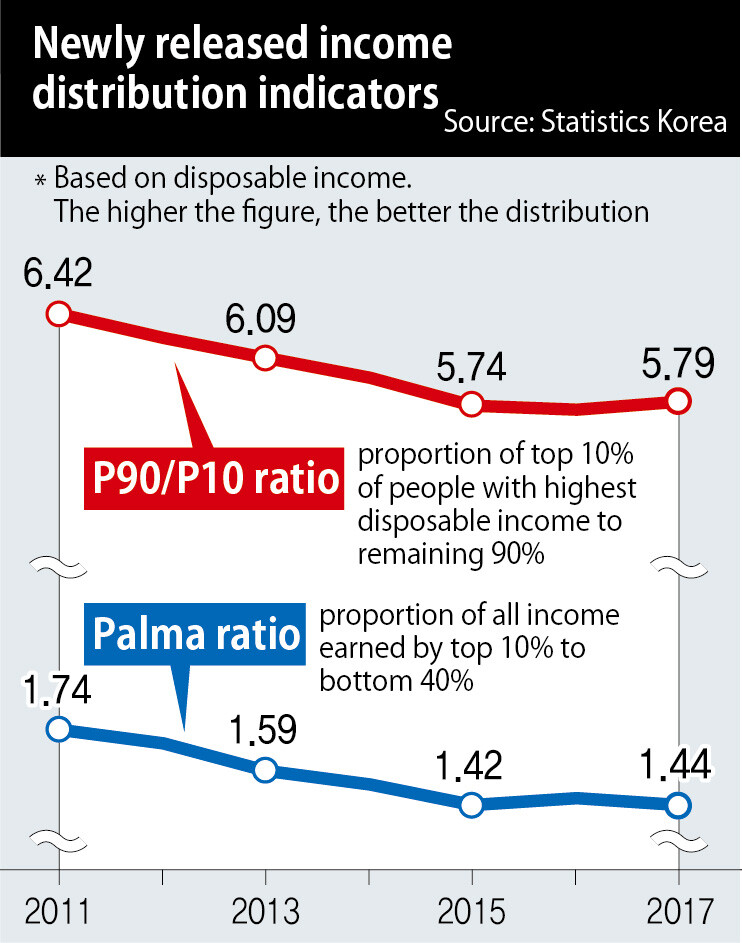hankyoreh
Links to other country sites 다른 나라 사이트 링크
South Korea’s income distribution still among bottom in OECD

Statistics Korea released new income distribution indicators based on the findings from a household financial welfare survey last year – with numbers indicating that South Korea remains ranked toward the bottom among OECD members.
On Apr. 11, Statistics Korea announced the publication of additional distribution indicators through the Korean Statistical Information Service (kosis.kr), including the Palma ratio, P90/P10 ratio, and relative poverty rate at 60% of the median income as calculated according to the findings from the household financial welfare survey. The indicators in question are used for international comparisons of income distribution alongside the Gini coefficient, which is considered the leading income distribution indicator.
To begin with, the P90/P10 ratio, or the ratio of the upper bound value of the ninth decile (the 10% of people with highest disposable household income) to that of the first decile, stood at 5.79 for 2017. The ratio had previously declined from 6.42 to 5.73 between 2011 and 2016, indicating steady improvement in income distribution, but rose again slightly to 5.79 for 2017. South Korea ranks 32nd in the OECD for P90/P10 ratio.
Also announced the same day was the Palma ratio, an indicator often used for international assessments of income distribution. The ratio compares the percentage of all income earned by the top 10% with that earned by the bottom 40%, with lower numbers indicating more favorable distribution. In terms of disposable income, South Korea recorded a Palma ratio of 1.74 in 2011; the number improved to 1.42 in 2015, but rose slightly to 1.44 in 2017. Among OECD members, South Korea ranked in 30th place for its Palma ratio – a similar level to past international rankings by Gini coefficient and other distribution indicators.
By Noh Hyun-woong and Lee Kyung-mi, staff reporters
Please direct comments or questions to [english@hani.co.kr]

Editorial・opinion
![[Column] Has Korea, too, crossed the Rubicon on China? [Column] Has Korea, too, crossed the Rubicon on China?](https://flexible.img.hani.co.kr/flexible/normal/500/300/imgdb/original/2024/0419/9317135153409185.jpg) [Column] Has Korea, too, crossed the Rubicon on China?
[Column] Has Korea, too, crossed the Rubicon on China?![[Correspondent’s column] In Japan’s alliance with US, echoes of its past alliances with UK [Correspondent’s column] In Japan’s alliance with US, echoes of its past alliances with UK](https://flexible.img.hani.co.kr/flexible/normal/500/300/imgdb/original/2024/0419/2317135166563519.jpg) [Correspondent’s column] In Japan’s alliance with US, echoes of its past alliances with UK
[Correspondent’s column] In Japan’s alliance with US, echoes of its past alliances with UK- [Editorial] Does Yoon think the Korean public is wrong?
- [Editorial] As it bolsters its alliance with US, Japan must be accountable for past
- [Guest essay] Amending the Constitution is Yoon’s key to leaving office in public’s good graces
- [Editorial] 10 years on, lessons of Sewol tragedy must never be forgotten
- [Column] A death blow to Korea’s prosecutor politics
- [Correspondent’s column] The US and the end of Japanese pacifism
- [Guest essay] How Korea turned its trainee doctors into monsters
- [Guest essay] As someone who helped forge Seoul-Moscow ties, their status today troubles me
Most viewed articles
- 1[Column] The clock is ticking for Korea’s first lady
- 2Hong Se-hwa, voice for tolerance whose memoir of exile touched a chord, dies at 76
- 3After 2 months of delayed, denied medical care, Koreans worry worst may be yet to come
- 4[Column] Has Korea, too, crossed the Rubicon on China?
- 5US overtakes China as Korea’s top export market, prompting trade sanction jitters
- 6Samsung barricades office as unionized workers strike for better conditions
- 7All eyes on Xiaomi after it pulls off EV that Apple couldn’t
- 8[Correspondent’s column] In Japan’s alliance with US, echoes of its past alliances with UK
- 975% of younger S. Koreans want to leave country
- 10[Correspondent’s column] The US and the end of Japanese pacifism